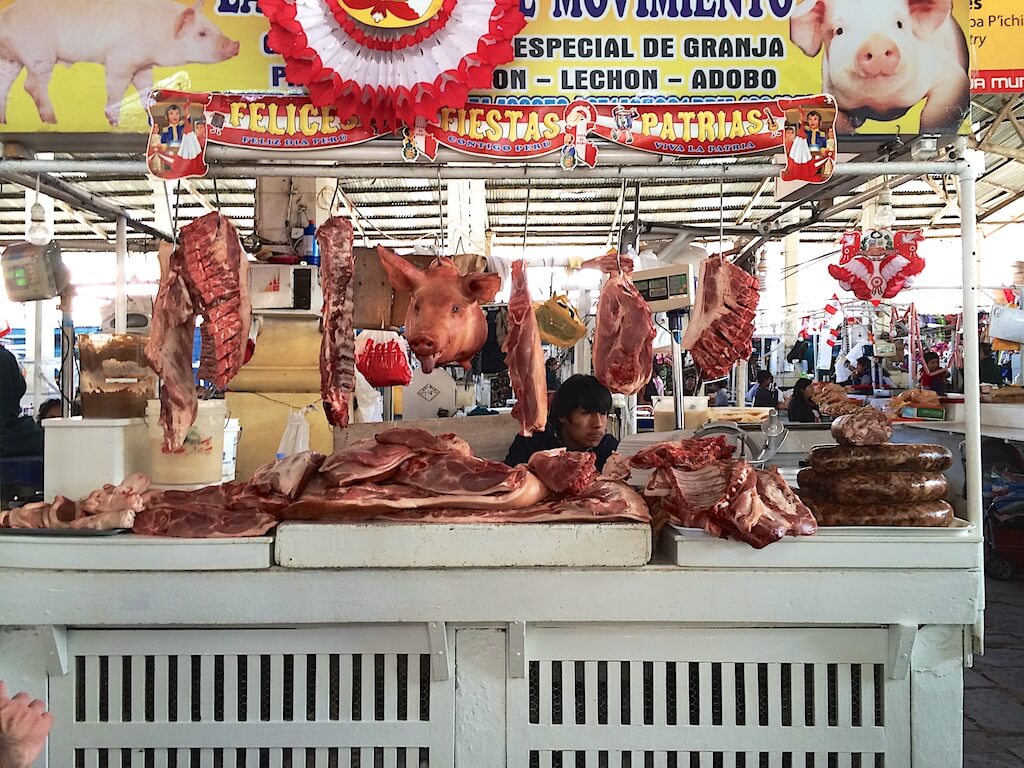
Picking up where I left off last, What seemed like a simple picture I snapped of a hanging pig head and a young vendor was actually more about what happened on the other side of the lens.
As the sun set on the day, Tony and I made our way to a square near the center of town to hook up with astronomy group tour. Upon arrival we met Tom and Sandra, a couple, as the coincidence begins, from NYC. Tom a native of Queens and Sandra a Peruvian living in New York. Minutes later two men approached and interrupted asking if we were waiting for the astronomy event. Immediately I recognized one of the men from New York. Although he lived in San Francisco. Here’s were it gets so coincidental that I had to think hard about James Redfield’s views.
“I don’t think that anything happens by coincidence… No one is here by accident… Everyone who crosses our path has a message for us. Otherwise they would have taken another path, or left earlier or later. The fact that these people are here means that they are here for some reason”…”
― James Redfield
Six months earlier I was late to dinner with my wife. While she waited in the Turkish restaurant on 34th street the two gentlemen at the table next to her engaged her in conversation. When I arrived the conversation continued. One of the men was visiting from San Francisco and always made it a point to visit this restaurant on his trips to NY. This man was the one standing in the square with us in Cusco while his friend inquired about the astronomy tour.
I explained the reason for my disbelief to both the man, who remembered me from the Turkish restaurant immediately, and the rest of the group. His friend interjected and asked if I had taken a photo of the pig head vendor at the market earlier that day. I turned to him, again in disbelief. “Yes, that was me”, I inquisitively replied. “I took that same picture. I was standing right next to you.”, he explained bemused. As I was digesting that, third coincidence, Sandra interrupted and explained that her and Tom had their first date at the same Turkish restaurant in New York where me and the man had met.
We all boarded the van, with a larger group of people, and drove out of Cusco to a small dark plot of land and looked up at the night sky. Sipping tea in the brisk darkness and taking turns looking through the telescope at the universe only punctuated the questions racing around my brain wondering if there was a reason for these overlaps. We looked at the face of the moon, mars and the Southern Cross (The southern hemisphere’s north star). In between I stared into the blackness between the stars. A few days earlier, in the Church of Santo Domingo, I learned the Incas were the only civilization who created a Zodiac in the negative space between the constellations. An artist had interpreted the Incas idea and it hung in the church museum. Below is a little gif showing the artists painting of the universe and the black space shapes the Incas saw..
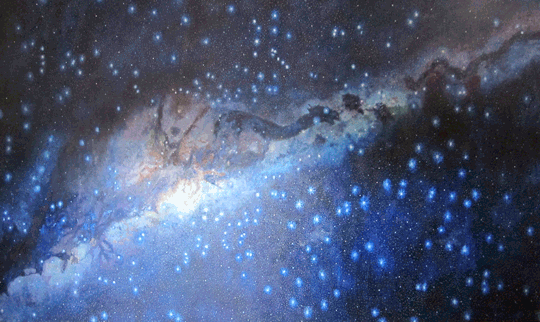 The night ended with two vans taking us back to Cusco. In a final coincidence, the six of us wound up in the same van separated from the rest of the group. When we were dropped off back in the center of Cusco we all went our separate ways but not before exchanging contact info. I still don’t know if, or what, the coincidences meant BUT according to James the reason may yet to be revealed.
The night ended with two vans taking us back to Cusco. In a final coincidence, the six of us wound up in the same van separated from the rest of the group. When we were dropped off back in the center of Cusco we all went our separate ways but not before exchanging contact info. I still don’t know if, or what, the coincidences meant BUT according to James the reason may yet to be revealed.
We ended our night with a coincidence of another sort. One much less cosmic. Two Italian kids finding an amazing Italian meal in the middle of high altitude Peru seems like quite fortuity to me. The below osso buco was perfectly braised and the home made raviolis the perfect accompaniment. Cicciolina does it right. Another second floor restaurant, the right table gets you a view out the window down onto the street as you eat. The eclectic interior doesn’t scream Italian but the kitchen is all business boot style. Serious Italian technique and language dominate and the plates that come out, although Peruvian flared, prove the kitchen is on point.
 Salt and the Earth
Salt and the Earth
The cosmic continued the next morning with our trip to Moray, an Inca ruin most famous for its enormous circular terraces. It was our final day in Cusco and we planned to squeeze out every last drop of the phenomenal city. We had booked ourselves an overnight bus ticket to Arequipa which left at 10:30pm. That gave us 15 and a half hours to check off as many things on the Cusco hit list as possible. By 7am we were in our driver/guide/flute player’s car. Richard Ccahua was another gentile, well informed, educated Peruvian guide that had the obvious genetics we’ve become aware indicates the Spanish-Quechuan mix.
Let me take a moment to plug our “fixer”. All our guides and transportation was organized by David at Sun Gate Tours, which we highly recommend. As I mentioned earlier, we could shoot him an email and an hour later he’d have a car and guide ready for us. Richard pulled off the road about 45 minutes after we climbed out of Cusco. The day was clearer than past and he’d stopped so we could take in the sharp, snow capped, Andes. Up at 11,500ft, this plateau allowed us a 180 degree expanse of arguably the toughest mountain range in the world.
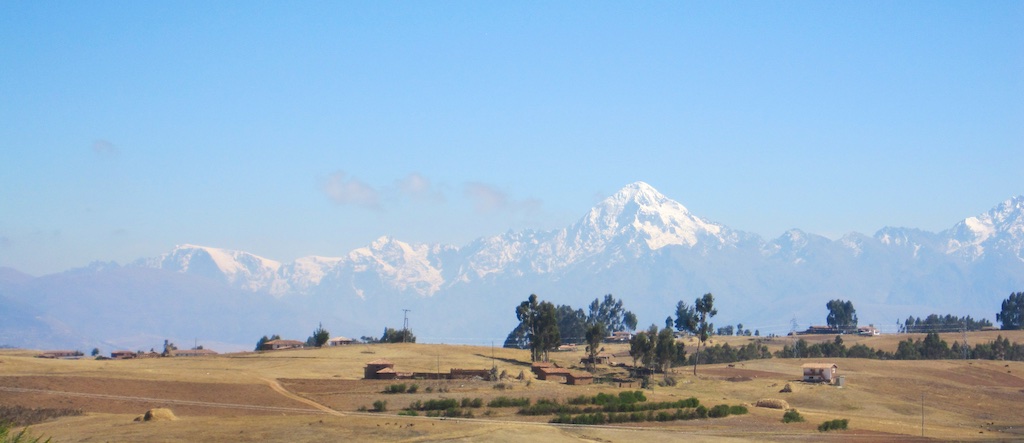 After about ten minutes of long, oxygen deprived, breaths and the sun warming our lungs we piled back into the car and continued our journey towards Moray. We detoured once more into a tiny town that I never caught the name. Up a winding dirt road and through a small village, where 4 older women were making cloth on a loom, our car kicked up a dust storm. A gaggle of young Peruvian girls donning American rock T-Shirts, acid washed jeans and Ugg style boots, gawked at our car as we zoomed passed. We stared back contemplating the Westernization of every dusty corner of this planet. Luckily we hadn’t seen an IKEA yet. The pit stop was to see a ruin that most don’t get the opportunity to view. Again, one of the benefits of private guides. Sitting on a hill across from the small town was an abandoned temple. One of the rest points on the Inca trail. When constructing the 20,000 miles of trail a simple algorithm was applied. Three days of walking to one day of rest. Referencing this as we explored the ancient village and sacred valley (our next post in the Peru series) we started to see how temples and surrounding villages were consistently places every 50 miles or so. This was the determined distance covered in a three day trek with gear and supplies before needing a full day of rest. Another testament to the hyper-fast, smart and methodical expansion of the empire.
After about ten minutes of long, oxygen deprived, breaths and the sun warming our lungs we piled back into the car and continued our journey towards Moray. We detoured once more into a tiny town that I never caught the name. Up a winding dirt road and through a small village, where 4 older women were making cloth on a loom, our car kicked up a dust storm. A gaggle of young Peruvian girls donning American rock T-Shirts, acid washed jeans and Ugg style boots, gawked at our car as we zoomed passed. We stared back contemplating the Westernization of every dusty corner of this planet. Luckily we hadn’t seen an IKEA yet. The pit stop was to see a ruin that most don’t get the opportunity to view. Again, one of the benefits of private guides. Sitting on a hill across from the small town was an abandoned temple. One of the rest points on the Inca trail. When constructing the 20,000 miles of trail a simple algorithm was applied. Three days of walking to one day of rest. Referencing this as we explored the ancient village and sacred valley (our next post in the Peru series) we started to see how temples and surrounding villages were consistently places every 50 miles or so. This was the determined distance covered in a three day trek with gear and supplies before needing a full day of rest. Another testament to the hyper-fast, smart and methodical expansion of the empire.
We finally entered the town of Maras, the gateway to Moray, and sped across the plains to the terraces. Out the window under the palatial Andes were burning fields and occasional cow herds. Arriving at the site we were anxious to set our gaze down into the highly crafted terraces. Of all the ruins and terraces we’ve seen, none had made us so curious. The Inca terrace system is an ancient technology boom. The brilliance in their terrace system design allowed for each level to create a different micro climate. Moray being the most obvious and prolific of this method. These micro climates simulated different altitudes which allowed for vegetation from those altitudes to thrive.
As we were standing at the precipice of the terrace we contemplated this genius. A 20,000 mile network of roads connecting coastal Lima to Amazonia to the high-Andes of Cusco, and every altitude in between, meant those traveling the system would naturally bring food (and seed) from other environments with them on their journey. The terraces allowed for cities that experienced no grow periods, say the harsh winters in the higher altitudes, to grow lower altitude food. You can see the brilliance now and Moray was the Einstein of them all. Moray’s terraces represent every altitude in the network. To bring this back to modern Peru, our meal at Central, in Lima, was organized by altitude. Each course contained an altitude measurement based on where the ingredients were sourced. As this thought resolved in my head Richard started playing a traditional harvest song on his flute. This was one of the biggest moments of the trip. Spoiler–Bigger than Machu Picchu. The melody of the flute, the thin breeze, the perfectly circular land and the feel of the fertile earth under my feet almost allowed me to taste the bounty while completely understanding the ingenious proliferation technique.
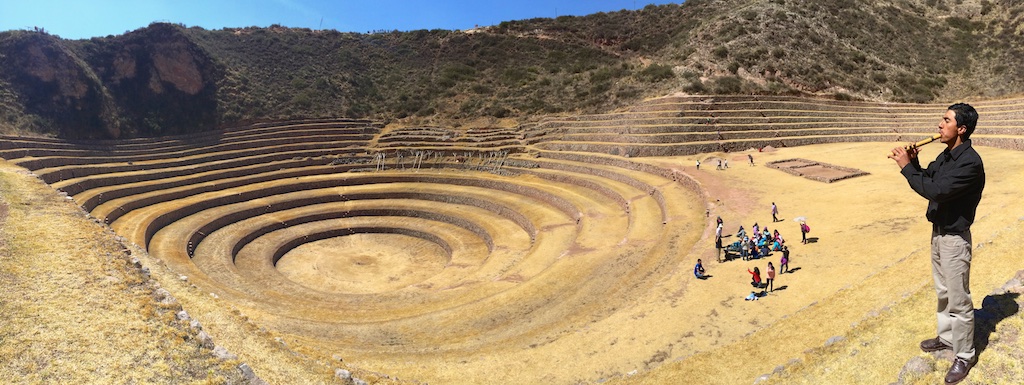 We climbed back up the terrace rings and hopped back in the car. Back through Maras we veered north instead of east the way we came. There was one more stop Richard had in mind before returning us to Cusco. A twenty minute drive across a dusty plateau and then up a winding canyon road revealed a sight I’d only seen once before – on the shores of Masala Sicily. Hugging the topography like a glacier, in the sharp ravine between two mountains were hundreds of salt pools. We had arrived at one of the most unique spectacles on earth. Salterns are usually found on coastal stretches in which the saline rich sea water is harvested into sodium chloride, salt. The quandary of this salt farm was that it was hundreds of miles from the coast. These pools are so unique because they are fed from a sping deep inside the mountain range that has an incredibly high saline content. The spring has been feeding this ravine since the days of the Inca which is a hell of a lot of water, let alone salty water. Where the mineral comes from and how it got into the water stream is still a bit of a mystery which makes our visit that much more exhilarating.
We climbed back up the terrace rings and hopped back in the car. Back through Maras we veered north instead of east the way we came. There was one more stop Richard had in mind before returning us to Cusco. A twenty minute drive across a dusty plateau and then up a winding canyon road revealed a sight I’d only seen once before – on the shores of Masala Sicily. Hugging the topography like a glacier, in the sharp ravine between two mountains were hundreds of salt pools. We had arrived at one of the most unique spectacles on earth. Salterns are usually found on coastal stretches in which the saline rich sea water is harvested into sodium chloride, salt. The quandary of this salt farm was that it was hundreds of miles from the coast. These pools are so unique because they are fed from a sping deep inside the mountain range that has an incredibly high saline content. The spring has been feeding this ravine since the days of the Inca which is a hell of a lot of water, let alone salty water. Where the mineral comes from and how it got into the water stream is still a bit of a mystery which makes our visit that much more exhilarating.
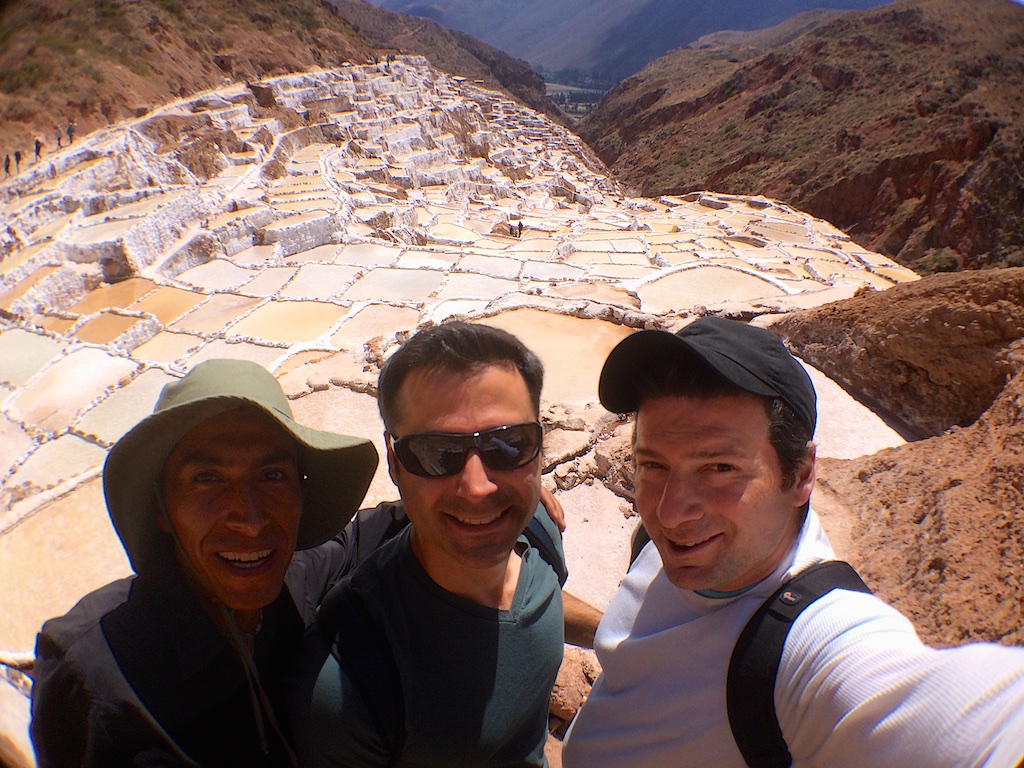 Richard gestures for us to walk down to the pools and then proceeds to take us across tiny walkways between the pool to get a closer look at the evaporation process. As water evaporates it leaves salt deposits on the side of the pools ready for harvest. Of course there was salt for sale and we couldn’t pass up buying a bag. It doesn’t get more straight from the source than that. Richard waved us up the hill pointing at his watch He knew we needed to be back to Cusco by 1pm for our chocolate making class. Leaving a final trail of dust, as we paralleled the Andes, we sped back through Moras and onto the highway that led us back to Cusco.
Richard gestures for us to walk down to the pools and then proceeds to take us across tiny walkways between the pool to get a closer look at the evaporation process. As water evaporates it leaves salt deposits on the side of the pools ready for harvest. Of course there was salt for sale and we couldn’t pass up buying a bag. It doesn’t get more straight from the source than that. Richard waved us up the hill pointing at his watch He knew we needed to be back to Cusco by 1pm for our chocolate making class. Leaving a final trail of dust, as we paralleled the Andes, we sped back through Moras and onto the highway that led us back to Cusco.
In the nib of time
Richard barely got us back in time to make the chocolate class. We pulled one of our favorite foreign travel moves. We had our driver call the chocolate school and explain our situation. That way he knew exactly where he was going and the teacher knew we’d be a little late for class. When we arrived they just finished the history of chocolate lesson and everyone was heading into the kitchen. Although we would have loved the history, the hands on work was really where our excitement focused. The hands on peppered some of that history in as we worked. This taught us some of the more primitive forms of chocolate consumption before the ubiquitous chocolate bar was the norm.
 We started straight from the beginning, almost. We did pull beans from a cacao pod but we skipped the fermenting process for obvious reasons that word implies. We picked it right up after that though. We took our beans and roasted them in the traditional clay pot method.
We started straight from the beginning, almost. We did pull beans from a cacao pod but we skipped the fermenting process for obvious reasons that word implies. We picked it right up after that though. We took our beans and roasted them in the traditional clay pot method.
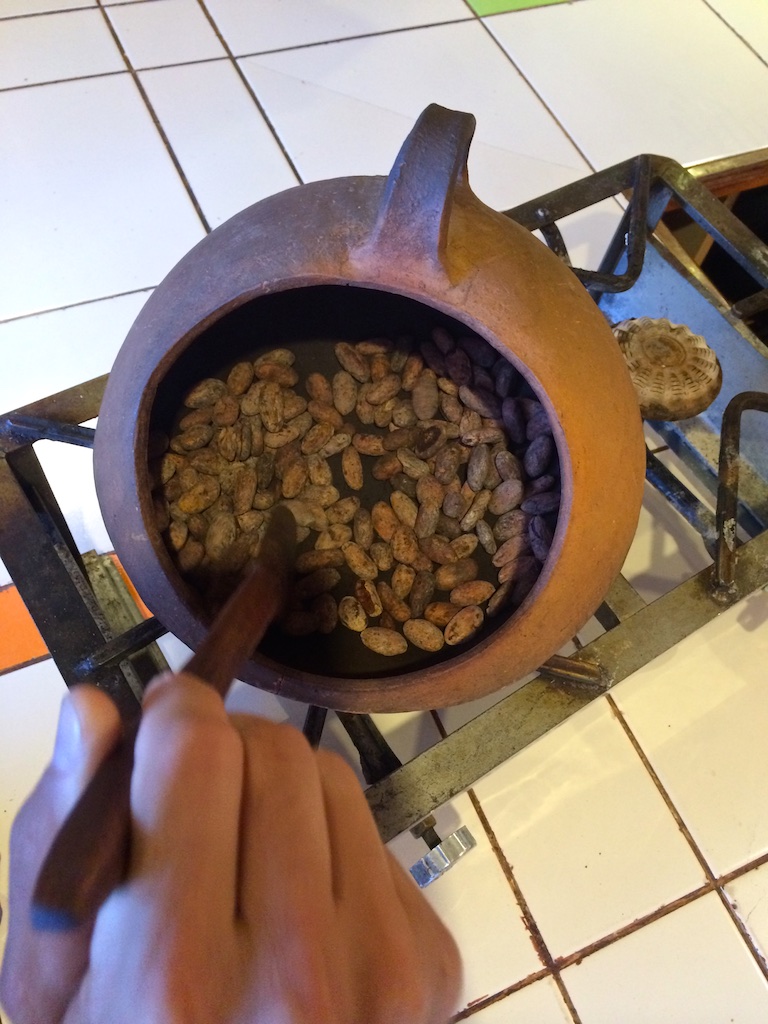 We then, shelled the beans, ground them with mortar and pestle until “liquid”. Lots of elbow grease in that process. Of course modern chocolate is mechanized and much simpler. From there we let a machine refine our chocolate before tempering. The tempering (raising and lowering the temperature of the chocolate) is what makes it shiny and not melt in your hand on contact. Once we had our base chocolate the creative part began. A huge box of molds were at our disposal so we could each make the shape we wanted.
We then, shelled the beans, ground them with mortar and pestle until “liquid”. Lots of elbow grease in that process. Of course modern chocolate is mechanized and much simpler. From there we let a machine refine our chocolate before tempering. The tempering (raising and lowering the temperature of the chocolate) is what makes it shiny and not melt in your hand on contact. Once we had our base chocolate the creative part began. A huge box of molds were at our disposal so we could each make the shape we wanted.
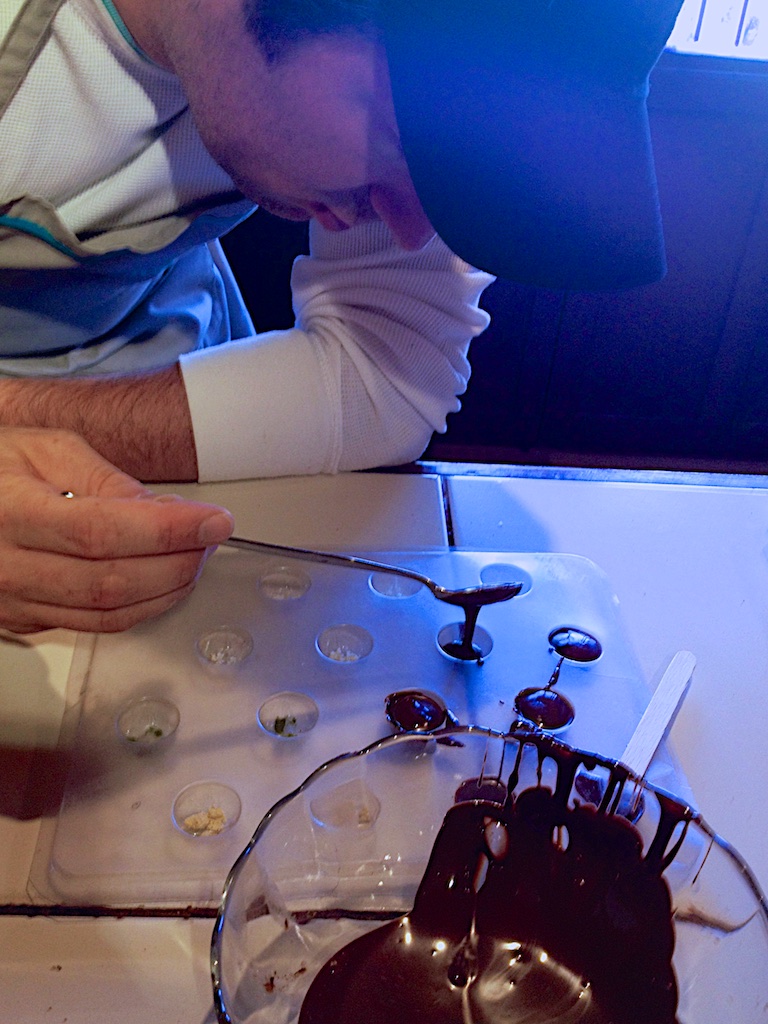 We also had a variety of add ins from chili to salt to ginger. The flavors we could create were seemingly infinite. I opted for a few of the coca spices since we’d been drinking the tea since we arrived in Cusco. Ant went for the more traditional chocolate combinations. Once we had our molds filled we placed them in a cooled room to let them harden up for a few hours.
We also had a variety of add ins from chili to salt to ginger. The flavors we could create were seemingly infinite. I opted for a few of the coca spices since we’d been drinking the tea since we arrived in Cusco. Ant went for the more traditional chocolate combinations. Once we had our molds filled we placed them in a cooled room to let them harden up for a few hours.
 With just a few hours left until we had to catch our bus we headed back for one more hit at Papachos to munch down some burgers and beers and enjoy a great final view of Cusco’s main square. With full bellies and a perfect buzz we picked up our, now solid, chocolate and headed to the hotel to gather our things and bid Cusco goodbye. Cusco is a great city to hang out in. A gateway to the Andes, Machu Picchu, the Sacred Valley and the Amazon it is BUT it’s culture, history and gastronomy is special in it’s own right. Plan on staying a while and soaking it in. The acclimation tip everyone warns against is real but you won’t be bored while your body adjusts. We promise.
With just a few hours left until we had to catch our bus we headed back for one more hit at Papachos to munch down some burgers and beers and enjoy a great final view of Cusco’s main square. With full bellies and a perfect buzz we picked up our, now solid, chocolate and headed to the hotel to gather our things and bid Cusco goodbye. Cusco is a great city to hang out in. A gateway to the Andes, Machu Picchu, the Sacred Valley and the Amazon it is BUT it’s culture, history and gastronomy is special in it’s own right. Plan on staying a while and soaking it in. The acclimation tip everyone warns against is real but you won’t be bored while your body adjusts. We promise.
![]()

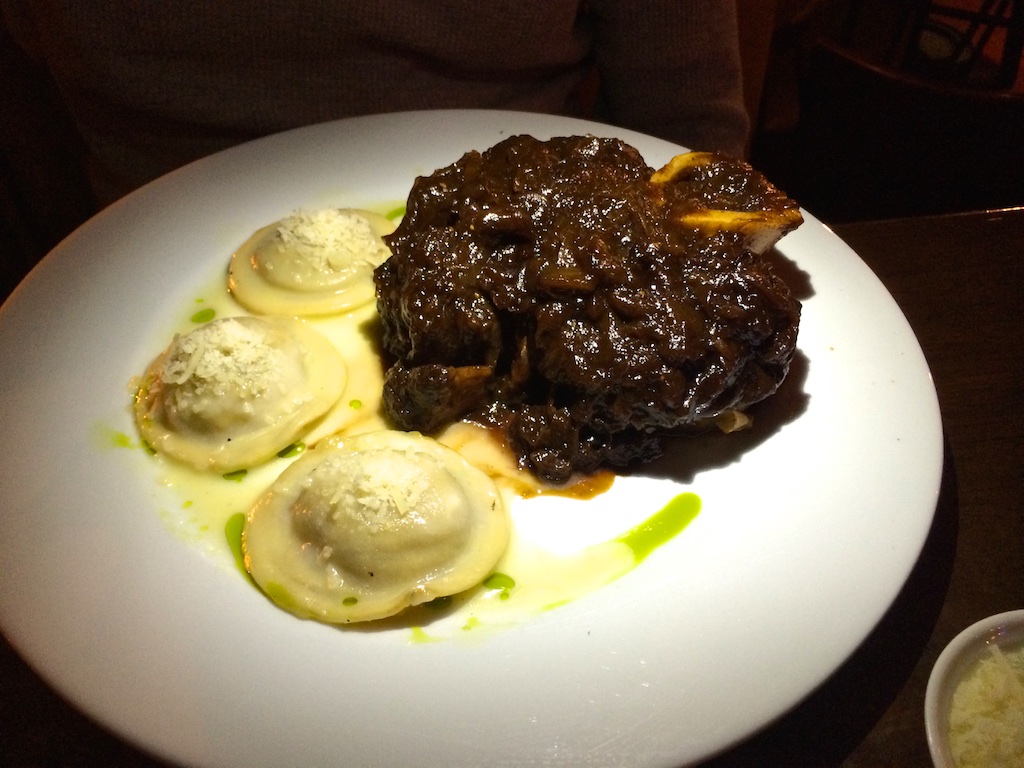 Salt and the Earth
Salt and the Earth
